Inside King Charles's fiery gathering that shone a light on his beliefs
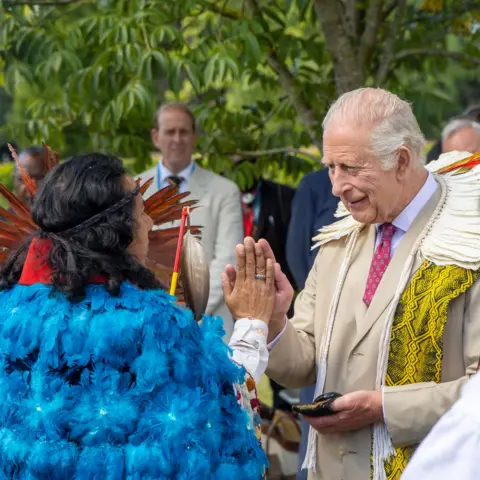 Ian Jones/The King’s Foundation
Ian Jones/The King’s FoundationIt wasn't exactly a run-of-the-mill royal occasion.
In the sunny gardens of the Highgrove estate, I stood in a circle with King Charles and an eclectic group who were attending his first "Harmony Summit".
We raised our arms in honour of nature as we stood around a fire, which was burning within a ring of flowers.
Presiding over the fire ceremony, in which we rotated as we honoured the north, south, east and west and then Mother Earth, was an Indigenous leader - an Earth Elder - wearing a headdress and a dazzling robe of blue feathers.
A conch shell was blown. Butterflies flew around the flowers. And, in a concession to modernity, as well as holding up feathers in a blessing for the King, the elder was reading his incantations from an iPhone.
There were people reaching to the sky, wearing colourful face paint and elaborate necklaces, while I held my palms up self-consciously, melting in my M&S suit.
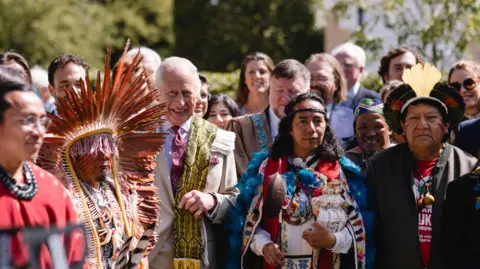 Courtney Louise/The King’s Foundation
Courtney Louise/The King’s FoundationThe summit was a celebration the King's philosophy of harmony with nature - an inaugural event that the King's Foundation hopes will become a regular gathering.
It brought together representatives from Indigenous peoples, including from tribes in the Amazon, along with environmentalists, climate campaigners, organic farmers, herbalists, educators, crafts people and philanthropists.
For good measure, there was Dwight from the US version of The Office, or at least actor Rainn Wilson, a director of a climate change group.
There were other visitors from Amazon too. A film crew from Amazon Prime, making a documentary for next year, who were poring over every moment as the sacred smoke coiled up over the apple trees in Gloucestershire.
The King, in a light summer suit, spoke a few quiet words of welcome, wearing a circlet of feathers and a scarf that had been draped ceremonially around his shoulders.
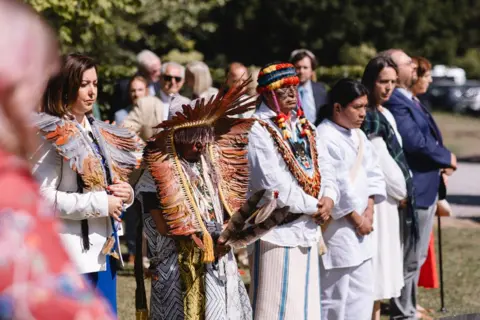 Courtney Louise/The King’s Foundation
Courtney Louise/The King’s FoundationA humane, ruminative, humorous and quietly radical figure, he was at the centre of what he hopes will become the first of many such gatherings.
But it raised the question - and perhaps opened a window - into what the King believes. What is this thoughtful man really thinking about?
Harmony is the King's philosophy, it means that we should be working with the grain of nature rather than against it. Or "her" as, he describes nature, in his book on the subject, published in 2010.
It's about the inter-connectedness of all life, infused with a strong sense of the spiritual, and the idea that the human and natural worlds can't be separated.
It's the philosophy that stitches together his many different pursuits - on the environment, climate change, sustainable farming, urban planning, architecture, protecting traditional craft skills and building bridges between different faiths.
According to a source close to the King, it's "perhaps the single most important part of his eventual legacy", bringing together different strands of his work that might seem separate into "one philosophical world view about creating a better, more sustainable world for future generations".
The King's views, including on the environment, were "once seen as an outlier, but now many elements have been accepted and adopted as conventional thought and mainstream practice, embraced around the world".
In his book on Harmony - A New Way of Looking at our World, the King describes his purpose as a "call to revolution", and writes that he recognises the strength of the word.
It's a broadside against a consumer culture, in which people and the natural world become commodities. He warns of the environmental threats to the future of the Earth. There's a call to protect traditional crafts and skills and also for a radical change in rejecting modern, unsustainable, exploitative forms of farming.
If not avant garde, he's an avant gardener.
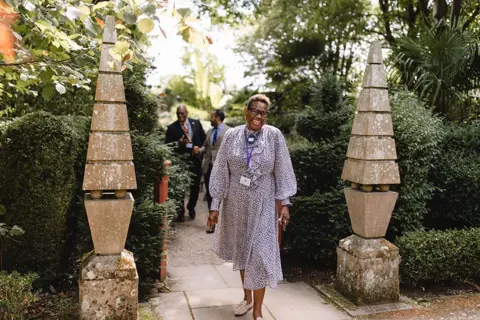 Courtney Louise/The King’s Foundation
Courtney Louise/The King’s FoundationIf you go for a walk in Highgrove's gardens there are small hurdle fences, with wooden rods woven around posts. The King makes these himself and this idea of things being inextricably woven together seems to be central to harmony.
His book moves from the importance of geometry, with patterns rooted in nature, to the designs in Islamic art and the inspiring dimensions of Gothic cathedrals.
A sense of the sacred in nature, as well as in people, seems to be an important part of this world view.
At lunch at the Harmony Summit, grace was said by the Bishop of Norwich, Graham Usher.
The King's idea of harmony dovetailed with a very deep personal Christian faith, he said.
"My sense is that he draws much of his energy and ideas from spending time in prayer and contemplation," said the bishop.
He said the King sees his role as serving others and a sense of this "is seen in how he is always keen to learn from other religious traditions, building bridges and fostering good relationships built on respect and understanding".
Within strands of Christianity, the King is also said to be have been interested in the Orthodox faith and its use of icons.
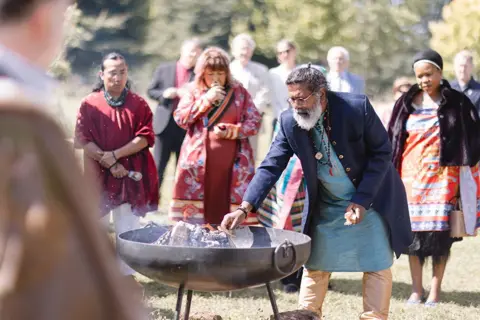 Courtney Louise/The King’s Foundation
Courtney Louise/The King’s FoundationHighgrove itself has an example of the King's private sense of spirituality. There is a small sanctuary tucked away in the grounds, where no one else goes inside, where he can spend time completely alone with this thoughts.
It must seem a world away from the ceremonial juggernaut of this week's state visit by France's President Macron.
The focus of this inaugural Harmony Summit was drawing on the wisdom of indigenous people, tapping into their knowledge and pre-industrial ways of working with nature.
Survivalist Ray Mears was there to welcome representatives of the Earth Elders group, who work to defend the rights of "original peoples", who have become the threatened guardians of the natural world. They were wearing traditional headdresses, face paint and ornaments, in among the flowers and trees of Highgrove.
"People's selfishness has taken them away from nature. They can't feel the breeze, they're too focused on the clock," said Mindahi Bastida, of the Otomi-Toltec people in Mexico.
The cacophonous modern world has broken our connection with nature, said Rutendo Ngara, from South Africa. She described our era as a time of "loud forgetting".
"We all have egos and ambitions. I wanted to be an entrepreneur, I wanted to sell out," said Uyunkar Domingo Peas Nampichkai, from Ecuador, the co-ordinator for the Amazon Sacred Headwaters Alliance.
The temptation for him was to sell his land for oil. He decided a different path and explained what "harmony" now meant to him.
"It's well-being for all human beings, all living beings, visible and invisible, it's Mother Nature… Everything is connected and there's mutual respect," he said.
These were people from forests and rivers who talked of the destructive pressures on them, from mining, oil and urbanisation.
The weren't pulling punches either. There were speakers warning of how "Europeans" had killed their people and another who said that the much-hyped COP climate change gatherings were full of empty promises that never delivered for grassroots communities.
Ailton Krenak, from Brazil, talked of rivers that that had been "erased by money" and seeing the dried-up, polluted waterways was like a much-loved "grandfather in a coma".
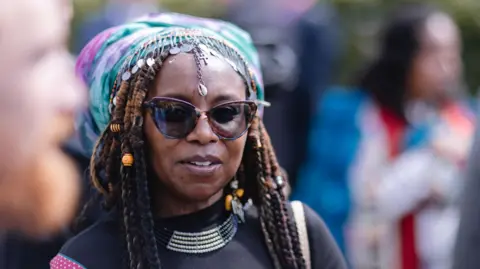 Courtney Louise/The King’s Foundation
Courtney Louise/The King’s FoundationBut how can harmony work in such a discordant world?
Patrick Dunne, who runs the educational Harmony Project which uses the concept in more than 100 schools in the UK, has been applying the principles in a place of extreme conflict, the war in Ukraine.
He's been taking classes of children traumatised by the conflict, and reconnecting them with nature, taking them to parks and forests for a place to heal.
"Ukraine is a powerful example of a country that's in a war they don't want and they are losing a lot of people. It's terrible, there's a lot of pain and suffering. And they want harmony, a future of living well together, so the message of harmony really resonates there," he said.
Highgrove, winningly wobbly with its crooked tiles and trees growing through holes in the roof of a shelter, is a lyrical sight on a summer's day. It's a model of harmony with nature.
How does that message work, when you step outside into an often angry, noisy and brutal world?
What makes the idea of harmony relevant, is that it puts ideas into practice, it's not just a "thought exercise", says Simon Sadinsky, executive education director at the King's Foundation, which teaches crafts skills to a new generation.
"It's not just a theoretical concept, it's not just a philosophy, it's grounded in practice," says Dr Sadinsky.
"There's a lot of awfulness going on in the world, it's hard to stay optimistic. You can feel completely powerless," says Beth Somerville, a textile worker who completed a King's Foundation course.
But she says the idea of "harmony in nature" inspires her work and helps to create things which can be both beautiful and functional, in a way that is "all connected".
"It does drive me to carry on and have hope," she says.
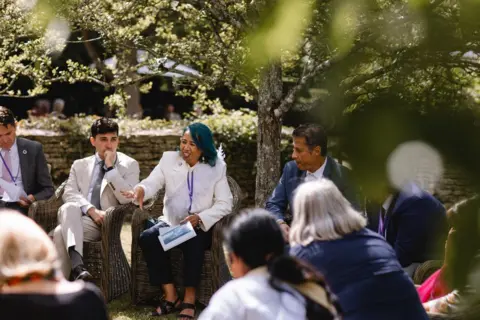 Courtney Louise/The King’s Foundation
Courtney Louise/The King’s Foundation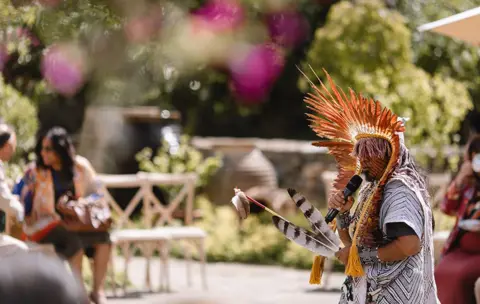 Courtney Louise/The King’s Foundation
Courtney Louise/The King’s Foundation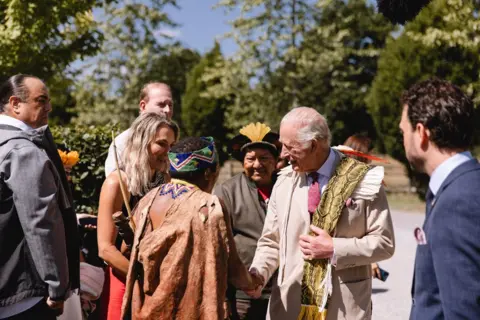 Courtney Louise/The King’s Foundation
Courtney Louise/The King’s Foundation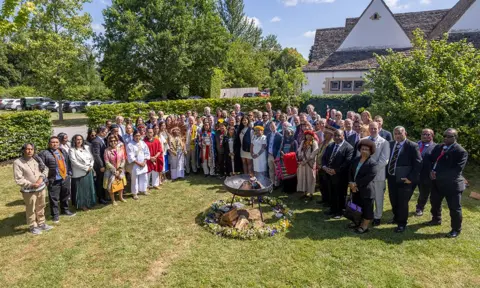 Ian Jones/The King’s Foundation
Ian Jones/The King’s Foundation